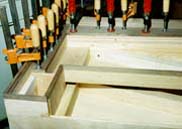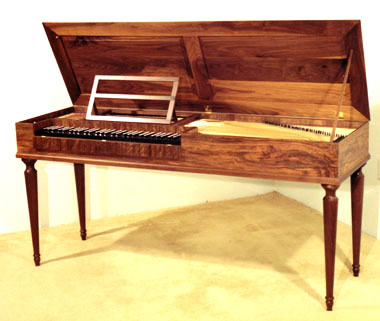Instruments
SINGLE AND DOUBLE MANUAL HARPSICHORDS
All of our harpsichords, both single and double manual, begin with a thorough study and understanding of the concepts intended by the original builders. We utilize aged Poplar for the case and internal bracing. Lids are assembled from solid Pine and Poplar so as to maintain flat panels without bowing. All wrests pins are treated with black oxide. Red and Yellow brass with soft iron wire are employed for stringing. Transposing keyboards are standard on all harpsichords. Each instrument is delivered with a canvas cover and a set of maintenance tools.
FLEMISH SINGLE MANUAL
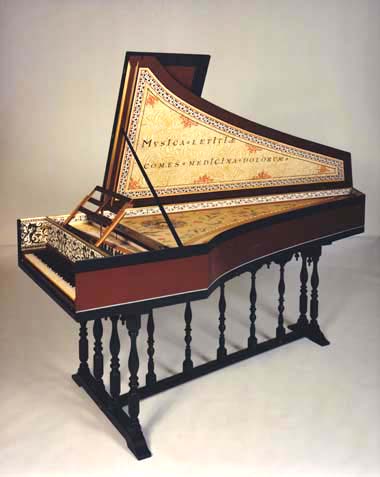 This single manual harpsichord is inspired by the 1646 Ioannes Couchet double manual that I measured and photographed in detail at the Brussels Museum. "Of all of the instruments I've researched, this is an undiscovered gem that is really quite profound".
This single manual harpsichord is inspired by the 1646 Ioannes Couchet double manual that I measured and photographed in detail at the Brussels Museum. "Of all of the instruments I've researched, this is an undiscovered gem that is really quite profound".
The instrument to the left is shown with traditional Flemish block printed papers. The baluster stand disassembles for easy transport.
The collapsible music rack shown is made of walnut with a hand rubbed finish.
Pear wood jacks and Delrin (or crow) plectra work in leather-covered registers. The bentside is steam bent and handstops are on the wrest plank. Bellyrails and lower bracing utilize sliding dovetail joints, ensuring the integrity of the instrument. The lid and closing flap are made of aged solid poplar.
SPECIFICATIONS
- Disposition: Single: 2' x 8', buff or 1x8', 1x4', buff. Double: 2' x 8', 1' x 4', buff
- Soundboard: Spruce
- Pitch: A=415
- Compass : GG-d" (56 notes) with transposer
- Naturals: Bone or Ebony
- Sharps: Ebony or Bog oak when available, Ebony with bone cap
- Size: 34' x 83' / Double: 34' x 89’
GERMAN DOUBLE HARPSICHORD (ZELL)
The German double harpsichord has a distinctive sound that is markedly different from the other schools. The bright, clear sound of the German instrument is as resonant as that of the French, but the German sound has a more neutral character. The German harpsichord might for this reason be considered the more versatile concert instrument. Our German double harpsichord is based on the instruments by Christian Zell, in particular, the Zell double in Hamburg. The case is made of 100 year old pine with sliding dovetail internal joints for a tight fit and attractive appearance. The soundboard is painted in authentic style. Delrin jacks and plectra work in leather covered registers (wooden jacks & crow-quill plectra are optional). The finish includes gold-leaf banding on the outside of the case and on the moldings. The decorative stand is similar to the original Zell in Hamburg.

- Disposition: 8' x 8' x 4',buff, shove coupler
- Soundboard: Engelmann or European Spruce
- Pitch: A=415, transposable
- Compass : FF-d" (58 notes)
- Naturals: Bone
- Sharps: Ebony
- Size: 36½’x 96’
SPECIFICATIONS
Alterations of the listed specifications are available by arrangement.
FRENCH DOUBLE
The standard type of concert harpsichord today seems to be the French double. The velvety, sensuous tone is immediately appealing, and case decorations reflecting the classical French approach are similarly deductive. Our French double harpsichords are based on the designs by Taskin and Hemsch. The case is made of aged woods. Delrin jacks and plectra work in leather-covered registers; wooden jacks and crow-quill plectra are optional. The instrument comes with a Louis XVI platform stand with six turned and fluted legs. Shown below with special carved and gilded cabriole stand.
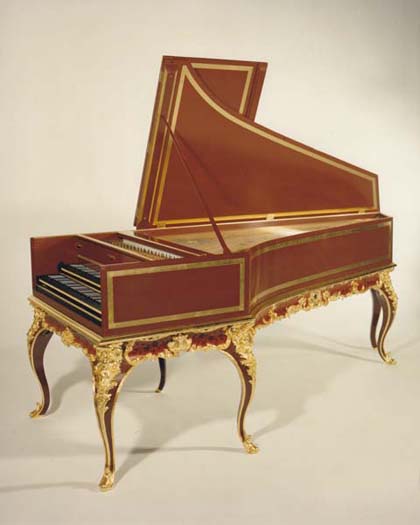
- Disposition: 8' x 8' x 4', buff on back 8', shove coupler
- Soundboard: European Fir or Spruce
- Pitch: A=415 transposable
- Compass : FF-e" (60 notes)
- Naturals: Ebony
- Sharps: Bone
- Size: 36'’x 92’
SPECIFICATIONS
FORTEPIANOS
MOZARTS FORTEPIANO(WALTER)
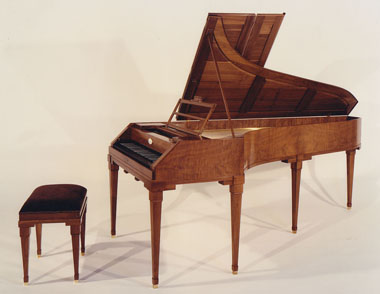 The Walter fortepiano is definitely at the forefront of the present day revival of the five-octave fortepiano. Of the several types of Viennese Classical fortepianos now being made, the Walter distinguishes itself with its especially rich quality and quantity of tone.
The Walter fortepiano is definitely at the forefront of the present day revival of the five-octave fortepiano. Of the several types of Viennese Classical fortepianos now being made, the Walter distinguishes itself with its especially rich quality and quantity of tone.
This is truly a concert instrument for the discriminating artist and carries well with any large orchestra or by itself. Meticulous attention to minute
detail has resulted in an instrument that is truly responsive to the musicians demanding standards.
Our Walter fortepiano is based principally on the one in the Mozarteum in Salzburg, but also on other Walter instruments which are in Linz and Eisenstadt. The case features walnut veneers and a solid lid design. Five Square tapered legs screw into position. Hammer escapement is adjusted through the use of convenient regulating screw. individual backchecks are used for ease of regulation. Knee levers control the damper lifter and moderator. The music desk is a true copy of Walter's distinctive design. The cabinet is finished in a hand-rubbed oil finish and all hardware is solid brass.
SPECIFICATIONS
- Soundboard: Englemann or European Spruce
- Pitch: A=415
- Compass : FF-f" 61 notes
- Naturals: Ebony
- Sharps: Bone-capped
- Size: 40'’x 88’
SPECIAL OPTIONS
- Compass extended to FF-g'''
- Hand-rubbed lacquer finish
- Matching bench
- Carrying Case for the Action
- Frame and paneled lid
- Veneers other than walnut
This instrument is based on extensive measurements of the true 'Mozart' fortepiano that is in the Salzburg collection. The original piano was in Mozart's possession at the time of his death. This is the instrument that much of his work was composed on.
The difficulty in building quality fortepianos is evidence of the high degree of workmanship inherent in all Lyon Instruments.
FORTEPIANO (STEIN/DULCKEN)
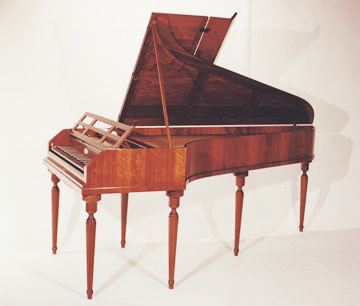 Johann Andreas Stein and Louis Dulcken represent a school of piano building quite apart from that of Anton Walter. While the Walter sound is very rich in both quality and quantity of tone, the sound of the Stein/Dulcken is more light and delicate. Our fortepiano is based on Stein's piano's at the Toledo Art Museum, and the Nuremberg collection, as well as the Dulcken piano in the Smithsonian Museum. The case features Walnut veneers and a solid Walnut lid. Six turned and fluted legs screw into place. Hammer escapement is adjusted through the use of convenient regulating screws. Individual backchecks are also used for convenience of regulation. A knee lever controls the damper lifter and a draw knob controls the moderator. The instrument is finished in a hand rubbed oil finish.
Johann Andreas Stein and Louis Dulcken represent a school of piano building quite apart from that of Anton Walter. While the Walter sound is very rich in both quality and quantity of tone, the sound of the Stein/Dulcken is more light and delicate. Our fortepiano is based on Stein's piano's at the Toledo Art Museum, and the Nuremberg collection, as well as the Dulcken piano in the Smithsonian Museum. The case features Walnut veneers and a solid Walnut lid. Six turned and fluted legs screw into place. Hammer escapement is adjusted through the use of convenient regulating screws. Individual backchecks are also used for convenience of regulation. A knee lever controls the damper lifter and a draw knob controls the moderator. The instrument is finished in a hand rubbed oil finish.
SPECIFICATIONS
- Soundboard: European Fir or Spruce
- Pitch: A=440 or 415
- Compass: FF-f (61 notes)
- Naturals: Ebony
- Sharps: Bone-capped
- Size: 38" x 84"
CLAVICHORDS
Our larger clavichord is based on the instrument in the Edinburgh collection and is supplied with four turned and fluted legs.
The Hubert is a smaller clavichord veneered in walnut with a paneled lid.
A basic clavichord is also available with a painted case instead of veneers.
SPECIFICATIONS (Hass)
- Soundboard: European Fir or Spruce
- Pitch A=415
- Compass: FF- f '''
- Naturals: Ebony
- Sharps: Bone-capped
- Size: 21" x 68"
Click HERE to listen to a Lyon Clavichord -- Text below and link compliments of John Citron - Owner of Lyon Clavichord shown above....
The clavichord was invented around 1400 and lasted as a private performance instrument until the mid 1840s, when by then the pianoforte had run it out of the private home. Originally it was used a practice instrument by organists because of its very soft tone. Later on, as keyboards grew in length, the clavichord did too. The clavichord became a popular private instrument because of its low cost, low maintenance, and relatively small size. The instrument was also favored by the North Germans, Swedes, and Danes because of its expressiveness.
The early instruments were very small with only 4-octaves or less. Later on, towards the end of the clavichord's lifetime, the instrument had nearly 6 octaves and was more than 6 feet long. There are two types of clavichords. The earliest instruments were fretted meaning that more than one key uses the same pair of strings. How this method works will be explained shortly. The later instruments were fully chromatic, and were unfretted meaning that each key had its own pair of strings. There are advantages and disadvantages to both designs. The unfretted instruments were generally smaller and lighter and a little louder due to the less strings over the soundboard.
It's interesting to note how versatile this instrument is. On my unfretted instrument with 5-octaves (FF-g'''), I can play most keyboard music dating from the early 16th century right through the early keyboard sonatas of Clementi. JS Bach, Carl Phillip Emanual Bach and many other composers including Haydn, Mozart and even Beethoven favored the clavichord for its expressive capabilities. CPE Bach wrote keyboard sonatas specifically for the clavichord, and in general most music written between the early 16th century right through 1800 was written for generic Klavier meaning just a keyboard so the music is at home on the harpsichord, portive organ, the clavichord, and in some cases even the pianoforte.
Background
All instruments crafted by Lyon Keyboard Instruments are inspired by historical instruments found throughout many major museums and private collections.
Materials are hand selected with meticulous attention to quality and how that will contribute to the sound and feel of the instrument.

While we offer fully decorated instruments reflecting the different schools of building, we can also offer these same instruments with just a single color finish and simple trestle stand. This approach will in no way compromise the tone or action feel in any respect.
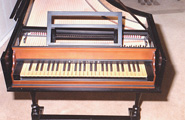
Italian Harpsichords - as shown above and below. Lyon offers an Italian instrument made of Port Orford or Alaskan Yellow Cedar strung entirely in brass.
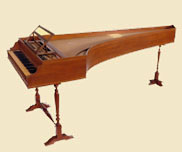
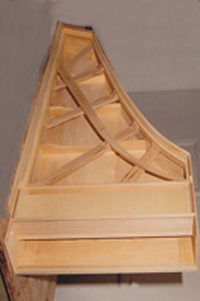
Germany produced at least two distinct schools of harpsichord making in the 18th century, of which only one - the Hamburg school - is represented by and appreciable number of surviving examples.
Whether new or rebuilt throu ugh the centuries, harpsichord's were often a major piece of decorative furniture. The soundboards were painted with flowers and intricate boarders, while the cases were painted or lacquered in any of a variety of fashionable styles.
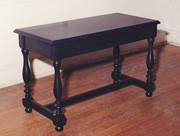
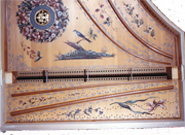
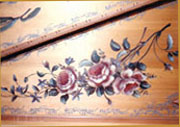
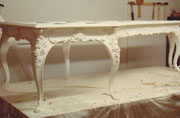
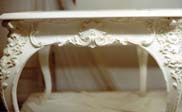
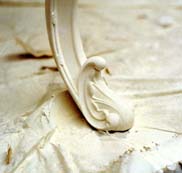
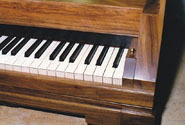
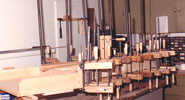
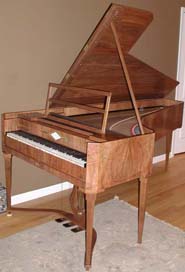
A shown above, the Strecher piano is six octaves and is well suited for many of the piano works by Schubert, Schumann, and Mendelssohn.
The legs can be removed on these pianos allowing the owner to easily transport the instrument for performances. An optional travel case for the fortepiano's action and damper rail will reduce the handling weight of the instrument while protecting the action in transit.
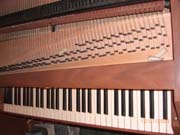
Walter keyboard shown above with bone covered naturals (by special order). Optional matching piano bench shown below.
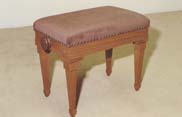
"A brief history of the Stein family of piano builders......The history of the family of Andreas Stein in connection to the art of piano making reaches back to the very early days of the invention of the pianoforte. At the beginning of the eighteenth century, the master Italian harpsichord builder Bartelomeo Christofori produced the first known stringed keyboard instrument with a hammer action that struck the strings rather than plucked them. Christoforti's "arpicembalo che fa il piano il forte" was remarkably advanced for such an early attempt, and included many of the basic rudiments of escapement and touch that were to become greatly refined over the next two centuries. German instrument makers quickly took the lead in the piano's early development, with Gottfried Silbermann producing his first hammer mechanism in 1726". Frank Renfrow copyright 2005

Assembly photos of the Hass clavichord (finished instrument shown to the left).
.jpg)
